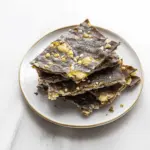This German Cucumber Salad, or Gurkensalat, is a classic side dish known for its cool, creamy texture and refreshing dill flavor. It combines paper-thin slices of crisp cucumber with a tangy sour cream dressing, balanced by a hint of vinegar and sweetness. Light, bright, and irresistibly simple, it’s a traditional favorite that brings a taste of German comfort to any table. Whether you’re serving it alongside bratwurst, schnitzel, or grilled fish, this salad brings a much-needed freshness to heartier meals. Perfect for summer barbecues, weeknight dinners, or your next potluck, it’s a dish that requires minimal effort but delivers big on taste. Once chilled and served, it becomes a creamy, cool bite that guests will keep coming back for.
Full Recipe:
Ingredients:
-
2 large English cucumbers
-
1/2 small onion, thinly sliced
-
1/2 cup sour cream
-
1 tablespoon white vinegar
-
1 tablespoon fresh chopped dill (or 1 tsp dried dill)
-
1 teaspoon sugar
-
Salt and pepper, to taste
Directions:
-
Thinly slice the cucumbers using a mandoline or sharp knife and place in a colander.
-
Sprinkle with a little salt and let sit for 20 minutes to draw out excess moisture.
-
In a bowl, mix sour cream, vinegar, dill, sugar, and a pinch of salt and pepper.
-
Squeeze the excess liquid from the cucumbers and pat dry with paper towels.
-
Add cucumbers and sliced onion to the dressing and mix gently to combine.
-
Chill in the fridge for at least 30 minutes before serving to allow flavors to meld.
Prep Time: 10 minutes | Cooking Time: 0 minutes | Total Time: 40 minutes (includes chilling)
Kcal: 90 kcal | Servings: 4 servings
Exploring the Classic German Cucumber Salad (Gurkensalat)
German cuisine is renowned for its hearty meats, dense breads, and robust stews. However, hidden among its more filling fare is a lighter, refreshing gem that offers balance to the rich flavors of traditional meals: Gurkensalat, or German Cucumber Salad. This simple yet elegant dish has graced German tables for generations and continues to be a staple side dish across households and restaurants alike. It’s not only easy to prepare but also incredibly versatile, pairing well with a wide array of dishes.
In this article, we’ll explore the history, cultural context, nutritional value, and variations of this beloved salad, as well as tips for serving and storing it.
The Roots of Gurkensalat in German Cuisine
Like many traditional European recipes, Gurkensalat has humble beginnings. It likely originated in rural areas, where home gardeners grew cucumbers in abundance during the warmer months. The recipe developed as a way to use up the fresh harvest in a cool, tangy salad that could complement heavier main courses.
The core idea behind Gurkensalat is its refreshing and contrasting flavor profile: crisp, mildly sweet cucumbers meet the richness of sour cream or tang of vinegar. In Germany, it is particularly common to serve this salad alongside meats like schnitzel, bratwurst, or roast pork, where its acidity helps cleanse the palate.
Regional Variations Across Germany
One of the most interesting aspects of Gurkensalat is how it varies from region to region. While the sour cream and dill version is perhaps the most internationally recognized, it’s far from the only way Germans enjoy cucumber salad.
-
Northern Germany: In this region, you’ll frequently find versions that include sour cream, yogurt, or crème fraîche, resulting in a creamier consistency. Dill is an essential herb, and some recipes add onions or garlic for depth.
-
Southern Germany and Bavaria: Here, a vinegar-based dressing is more popular. Instead of dairy, the cucumbers are marinated in a mixture of white vinegar, sugar, oil, and salt. Mustard or a splash of lemon juice may also be added for brightness.
-
Eastern Germany: Influenced by Polish and Eastern European cuisine, cucumber salads here may include boiled potatoes or eggs, transforming the dish into a heartier, stand-alone salad.
These subtle yet distinct variations reflect Germany’s diverse culinary landscape and the adaptability of simple recipes to local preferences and ingredient availability.
Nutritional Benefits of German Cucumber Salad
German Cucumber Salad is more than just a tasty side dish it’s also a nutritious option for those looking to maintain a balanced diet.
-
Low in Calories: Cucumbers are over 95% water, making this salad naturally low in calories. Even with the addition of sour cream or oil-based dressings, it remains a light choice compared to creamy pasta or potato salads.
-
Hydrating: The high water content in cucumbers makes this dish incredibly hydrating, which is especially beneficial during summer months.
-
Rich in Antioxidants: Cucumbers contain antioxidants like beta-carotene and flavonoids that help reduce inflammation and oxidative stress in the body.
-
Digestive Health: Fresh dill, often used in the recipe, has long been valued for its digestive benefits. It can help reduce bloating and aid in digestion after a heavy meal.
-
Source of Micronutrients: The salad contains small amounts of vitamins K and C, as well as minerals like potassium and magnesium.
Overall, German Cucumber Salad offers a fresh, clean flavor while contributing valuable nutrients to your plate.
When and How to Serve Gurkensalat
One of the greatest strengths of this salad is its versatility. It’s suitable for a variety of occasions and meals, including:
-
Everyday Family Meals: Serve it as a light, flavorful side to complement meat-based dishes, casseroles, or grain bowls.
-
BBQs and Grilling Season: Gurkensalat is a go-to side dish during summer cookouts. It adds a cooling element to grilled meats and sausages.
-
Holiday Dinners: Its bright and herbal flavor profile balances out the richness of traditional holiday fare like roast goose or pork.
-
Potlucks and Gatherings: This salad travels well and can be made in advance, making it ideal for parties and social events.
Pro tip: Always serve it chilled. The cooler temperature enhances the crispness of the cucumbers and allows the dressing to set and meld for a more cohesive flavor.
Storage Tips and Make-Ahead Advice
German Cucumber Salad is best enjoyed fresh, but it can be made a few hours in advance or even the day before. However, because cucumbers contain a high amount of water, they tend to release liquid over time. To combat sogginess:
-
Salt the Cucumbers First: As in most traditional recipes, salting and draining the cucumbers helps remove excess moisture. This step is key to maintaining a crunchy texture.
-
Use Thick Dairy: If making a sour cream version, opt for a full-fat variety. Low-fat or thin sour creams may become watery.
-
Chill Before Serving: Let the salad rest in the refrigerator for at least 20-30 minutes before serving. This allows the flavors to develop and deepen.
-
Storage Duration: Store leftovers in an airtight container in the refrigerator for up to 2 days. After that, the cucumbers may become overly soft and diluted in flavor.
Common Additions and Twists
While the traditional version is delicious on its own, Gurkensalat is highly customizable. Here are a few additions that can elevate or alter the flavor profile:
-
Red Onion or Shallots: Adds a bit of sharpness and contrast.
-
Garlic: A minced clove can intensify the savory depth.
-
Fresh Herbs: Dill is classic, but parsley, chives, or tarragon can offer different flavor notes.
-
Greek Yogurt: Substituting some or all of the sour cream with yogurt adds protein and a slight tang.
-
Apple Cider Vinegar: Offers a sweeter, fruitier twist to the dressing.
-
Mustard or Horseradish: Adds a punchy kick to creamy versions.
-
Sunflower Oil: Common in Eastern European versions, adds a delicate nutty flavor when paired with vinegar-based dressings.
Feel free to experiment and adjust according to your preferences or dietary needs.
Why You’ll Love German Cucumber Salad
Whether you’re new to German cuisine or simply looking for a quick, refreshing side, Gurkensalat delivers every time. It’s quick to prepare, requires no special equipment, and uses ingredients that are easy to find year-round. Its mild, tangy flavor is universally appealing, and it offers a great way to add some green to your plate without overwhelming other flavors.
What’s more, the balance between the creamy dressing and crisp cucumbers makes this salad feel indulgent without being heavy. It’s one of those recipes that’s both nostalgic and timeless—reminding many of home-cooked meals from childhood while still fitting seamlessly into modern, health-conscious menus.
Conclusion:
German Cucumber Salad, or Gurkensalat, is a culinary treasure that embodies simplicity, flavor, and tradition. With its refreshing texture, versatile nature, and nutritional value, it’s no wonder this dish has remained a favorite for generations. Whether served at a festive gathering, alongside grilled meats, or as a cooling companion to rich dishes, this salad earns its spot as a staple in any kitchen.






